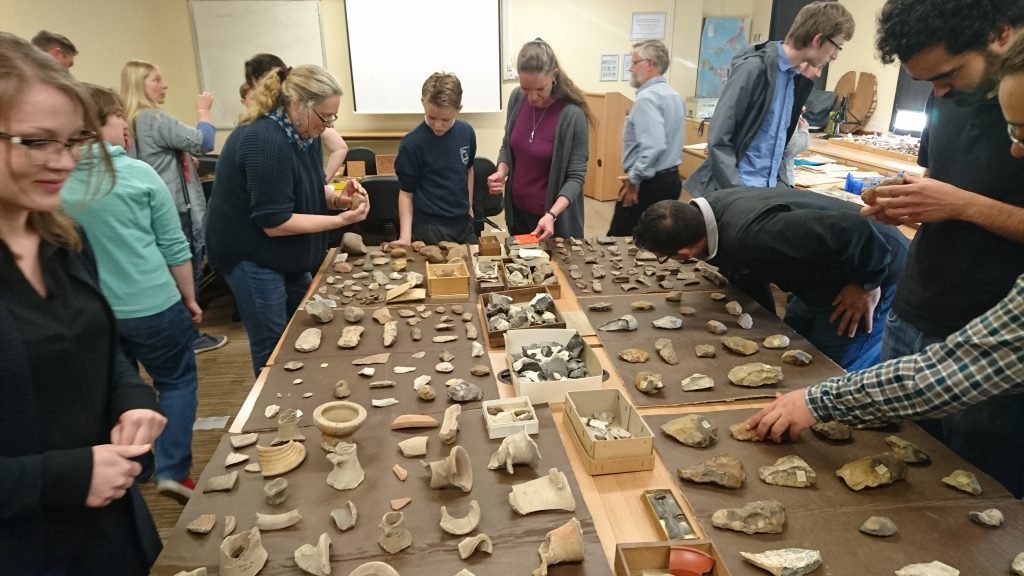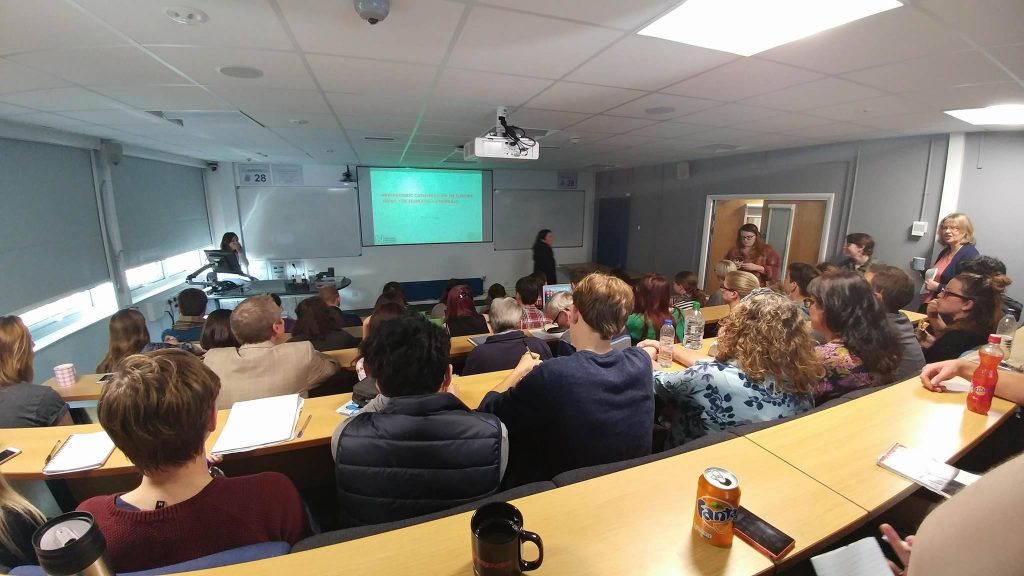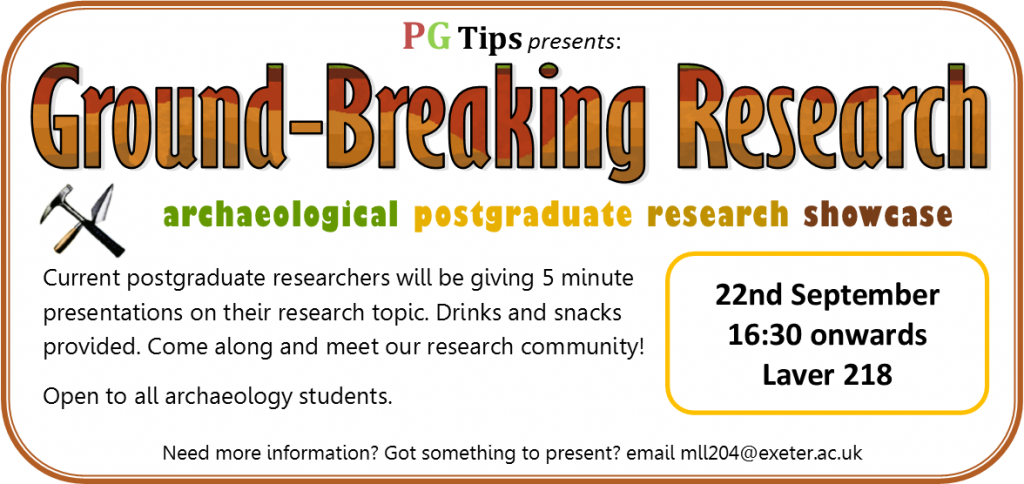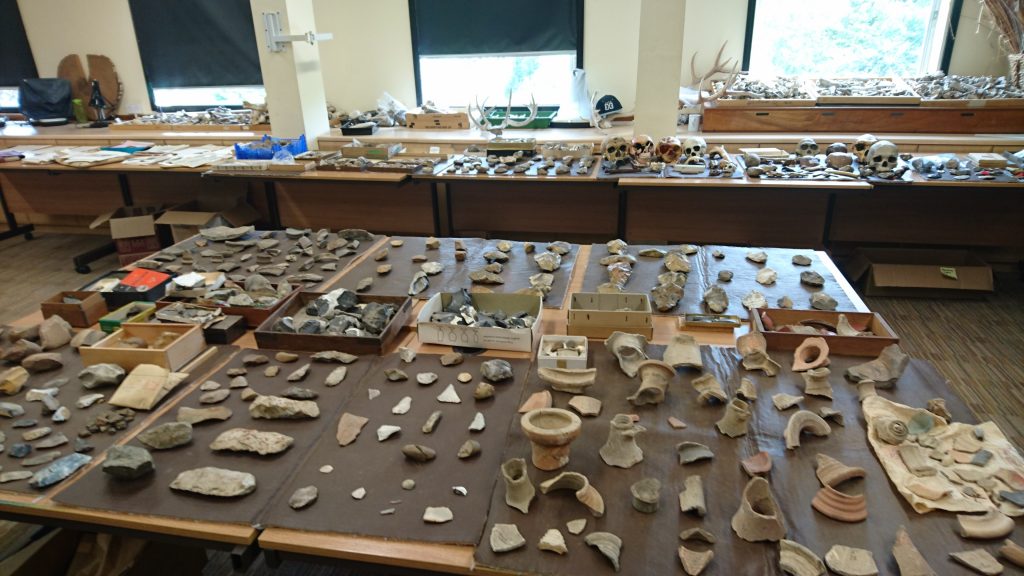The post Archaeology Research Seminars 2017-18 first appeared on ARCHAEOLOGY AT EXETER.
]]> The new academic year is upon us, and we’ve got a brilliant programme of research seminars to deliver for the next two terms! Almost all research seminars will take place on Thursdays, from 2:30-3:30pm, in Laver LT3. All are welcome to attend.
The new academic year is upon us, and we’ve got a brilliant programme of research seminars to deliver for the next two terms! Almost all research seminars will take place on Thursdays, from 2:30-3:30pm, in Laver LT3. All are welcome to attend.
Click the link below for the Research Seminar programme!
Archaeology_Research seminars_2017-18
The post Archaeology Research Seminars 2017-18 first appeared on ARCHAEOLOGY AT EXETER.
]]>The post Research Seminar 13/10/16 | Dr Silvia Bello: Prehistoric Cannibalism in Europe first appeared on ARCHAEOLOGY AT EXETER.
]]> It was a full house last week for Dr. Silvia Bello’s presentation on prehistoric cannibalism. She began by defining cannibalism, highlighting the difference between funerary de-fleshing of individuals and evidence of eating flesh, which could possibly look the same in the archaeological record. She particularly showed evidence of human gnawing on bones can be instrumental in implying that humans were being eaten. Through analysing the micromorphology of human cutmarks Bello also showed it was potentially possible to differentiate between butchered (cannibalised) bones and bones that were cleaned when not wholly fleshed. She suggested that we separate cannibalism into certain classes, particularly into “necessity” cannibalism and “choice” cannibalism, and gave archaeological and historical examples of each. Finally Bello encouraged us to think not of cannibalism as such a taboo as it is an integral part of cultures around the world. We thank Dr Bello for a fascinating research topic, which this blog does not do justice! You can find out more about her research here.
It was a full house last week for Dr. Silvia Bello’s presentation on prehistoric cannibalism. She began by defining cannibalism, highlighting the difference between funerary de-fleshing of individuals and evidence of eating flesh, which could possibly look the same in the archaeological record. She particularly showed evidence of human gnawing on bones can be instrumental in implying that humans were being eaten. Through analysing the micromorphology of human cutmarks Bello also showed it was potentially possible to differentiate between butchered (cannibalised) bones and bones that were cleaned when not wholly fleshed. She suggested that we separate cannibalism into certain classes, particularly into “necessity” cannibalism and “choice” cannibalism, and gave archaeological and historical examples of each. Finally Bello encouraged us to think not of cannibalism as such a taboo as it is an integral part of cultures around the world. We thank Dr Bello for a fascinating research topic, which this blog does not do justice! You can find out more about her research here.The post Research Seminar 13/10/16 | Dr Silvia Bello: Prehistoric Cannibalism in Europe first appeared on ARCHAEOLOGY AT EXETER.
]]>The post BioarchRG Session 1: developmental stress, life course and osteoarchaeology first appeared on ARCHAEOLOGY AT EXETER.
]]>You can follow reading group related posts on twitter using the #BioarchRG hashtag.
The topic of the paper was agreed to be extremely interesting. Gowland’s central argument was that stresses affecting a pregnant mother, such as famine, disease or social stress, can cause different phenotypic expression in the foetus due to epigenetic plasticity. Later in the foetus’s life these developmental stresses could cause greater susceptibility to diseases and may affect future generations as the foetus itself was affected. If socioeconomic circumstances can have intergenerational effects, including disease susceptibility and growth stunting, archaeological skeletal osteobiographies can no longer be considered individually. The paper had particular impact for all participants in the discussion as we thought back to our own family histories of stress, wondering if we had been affected, and perhaps worried (probably needlessly) about how we were already making our future generations susceptible to disease!
Discussions on the paper centred on some key themes. Beginning with the strengths and weaknesses of the paper, participants quickly picked up on some striking ethical issues that would be encountered in taking this work further. These particularly related to placing blame on an individual, particularly on the mother, for the health of an infant. Also, in testing historically stressed populations to find the long-reaching consequences of pan-generational stresses, would we somehow imply that population was biologically inferior? This discussion was lengthy and slightly off topic, so PhD student Belinda Tibbetts, who was running this week’s session, brought us back on track.
We questioned what the study means for the field of human osteoarchaeology. It was generally agreed that it would be particularly hard to apply the theory of pan-generation phenotype plasticity (and expressions thereof) in a ‘standard’ bioarchaeological situation, where the identity of the individual and their relationship with other individuals in the sample is unknown. We also worried about markers of palaeopathology, particularly stress indicators like enamel hypoplasia and lesions, which considering Gowland’s article could now no longer relate directly to an individual’s life conditions, but indeed to their mother’s and grandmother’s. We settled that until more work is carried out in this area we must continue to describe instances of palaeopathology as before, whilst keeping in mind that it could be an expression of generations of developmental stressors.
In short, the Bioarchaeology Reading Group had a great first meeting, with good discussions and well-made points. Keep an eye out for following sessions if you’re interested! While aimed at postgraduates, the session is also open for keen undergraduate students.
References
Gowland, R.L., 2015. Entangled lives: Implications of the developmental origins of health and disease hypothesis for bioarchaeology and the life course. American journal of physical anthropology, 158(4), pp.530-540.
Written by Emily Johnson
The post BioarchRG Session 1: developmental stress, life course and osteoarchaeology first appeared on ARCHAEOLOGY AT EXETER.
]]>The post Research Seminar 06/09 | Imogen Wood: Gunwalloe through the ages first appeared on ARCHAEOLOGY AT EXETER.
]]>The post Research Seminar 06/09 | Imogen Wood: Gunwalloe through the ages first appeared on ARCHAEOLOGY AT EXETER.
]]>The post Research Seminar 29/09/16 | Stephen Oppenheimer: Peopling the Indo-Pacific Region first appeared on ARCHAEOLOGY AT EXETER.
]]>You can read more about Professor Oppenheimer’s research in many of his publications.
The post Research Seminar 29/09/16 | Stephen Oppenheimer: Peopling the Indo-Pacific Region first appeared on ARCHAEOLOGY AT EXETER.
]]>The post Ground-Breaking Research Showcase 2016 first appeared on ARCHAEOLOGY AT EXETER.
]]>First our PGtips hosts Ethan and Malene welcomed us to a new academic year, explaining that usual sessions have two 20 minute presentations rather than the quick fire overviews students would be seeing today. Presentations began with Emily Johnson speaking about her research on bone fat processing and butchery at the time of the first dairying economies in Neolithic central Europe. Brice Girbal followed with an overview on his near-completed work with crucible steel production in India. Jemma Singleton continued the Indian theme with a description of her work on Neolithic rock art in India. Belinda Tibbetts then spoke about her research on infant and maternal health through analysing skeletal remains. Ethan Greenwood retook the stage to present on the Roman iron industry in the Weald. Elspeth St. John-Brooks, one of our joint AHRC SWW DTP students usually in Reading, showed us some of her work on soil geochemistry. Sabine Martin moved the presentations in the direction of the Palaeolithic with her talk on vein quartz tools. Finally, Alice la Porta presented her research on Neanderthal tool technology, finishing our session by showing us some of her experimental spears and arrows.
Many thanks to all of our researchers for kicking off this academic year so well, and thanks to all who attended. PGtips runs roughly every three weeks – if you’re a student at Exeter who is interested in presenting email Malene Lauritsen (*protected email*), or follow our facebook group.
The post Ground-Breaking Research Showcase 2016 first appeared on ARCHAEOLOGY AT EXETER.
]]>The post Ground-breaking research, 22nd Sept first appeared on ARCHAEOLOGY AT EXETER.
]]>
Next Thursday (22nd September) will be our annual Ground-breaking Research Showcase, where current PhD students will be giving 5 minute presentations on their theses. This is a great chance for new and current students to immerse themselves in the research happening in the department and to meet their colleagues. There will be presentations on zooarchaeology, metallurgy, human osteology, experimental archaeology, and more!
The session starts at 16:30 and is expected to run for around an hour. Join us in Laver 218 (second floor, at the front of the building) for research, drinks and baked goods!
The post Ground-breaking research, 22nd Sept first appeared on ARCHAEOLOGY AT EXETER.
]]>The post Archaeological Fieldwork, Romania first appeared on ARCHAEOLOGY AT EXETER.
]]>Sarmizegetusa, founded by Roman veterans of the Dacian war early in the second century, once had a population of over 20,000 and boasted an amphitheatre, several temples, and forum. Much of the site – including the forum and coliseum – has been excavated and turned into an archaeological park.
This year, Exeter students and students from Vienna, Heidelberg, and Romania, will participate in efforts to excavate the hypocaust of the governor’s mansion and to locate the north city gates. Students will also attend lectures on various aspects of Roman civilisation, visit local museums and archaeological sites, and tour the Transylvania region of Romania.
Written by Donna Thompson, arranged by Emily Johnson.
The post Archaeological Fieldwork, Romania first appeared on ARCHAEOLOGY AT EXETER.
]]>The post Experimental Archaeology: Neanderthal Spear Technology first appeared on ARCHAEOLOGY AT EXETER.
]]>Did Neanderthal use stone-tipped wooden spears as throwing hunting weapons?
In Europe, a small number of wooden spears have been found in archaeological contexts from the Lower and Middle Palaeolithic (c. 1,200,000-40,000 years ago), such as at Schöningen, Clacton and Lehringen. The first suggestion that such spears had stone tips comes in the European Middle Palaeolithic, the time of the Neanderthals, in the form of distinctive stone points, also called Levallois or Mousterian points. But how can we be certain that these stone points were used by Neanderthals as spear-heads for their wooden spears? Analysing the utilization wear and the impact fractures present on the surfaces of modern, experimentally-used spear-tips and archaeological stone points, using optical and digital microscopes, is one approach to inferring the prehistoric uses of these tools.
A big question in any discussion of Middle Palaeolithic spears is…how were Neanderthals using their stone-tipped wooden spears? Where Neanderthals throwing their spears or were they using them as close-range thrusting weapons? It has previously been argued that, while Neanderthal populations may have used stone-tipped wooden spears, these were rudimentary thrusting weapons. However the differences between throwing and thrusting spear delivery systems are still poorly understood for the earlier Palaeolithic, both in terms of spear performance and concerning the traces left behind on the spear tips. This partly reflects the limited range of experiments which had, until recently, been undertaken.
Building on previous archaeological experiments, and drawing on ethnographic observations, I am conducting a series of weaponry experiments within my PhD research project. The experiments aim to test the performances of replica Middle Palaeolithic stone-tipped wooden spears, and explore the differences in the resulting wear and breakage patterns that can be seen on the thrown and thrusted spears.
The experiments have been funded by the UK’s South West and Wales Doctoral Training Partnership (SWW DTP), the Arts and Humanities Research Council (AHRC), and the University of Exeter. They are taking place at Aöza Open-air Museum “Steinzeitpark Dithmarschen” (Albersdorf, Germany) within the OpenArch/EXARC partnership. The support of all of these organisations is very gratefully acknowledged.
Written by Alice La Porta, adapted for blog by Emily Johnson.
The post Experimental Archaeology: Neanderthal Spear Technology first appeared on ARCHAEOLOGY AT EXETER.
]]>The post Desmond Collins Teaching Collection first appeared on ARCHAEOLOGY AT EXETER.
]]>
Professor Bruce Bradley gave us a brief insight into the fascinating life of the man responsible for this collection and eloquently described how influential, useful and vital it will prove for future teaching in the department. Having already used some of the hominin casts in a Widening Participation lecture with Year 12 students I can certainly attest to how much they engage learning in the classroom. Professor Bradley praised the family of Desmond Collins, calling the collection his “lasting legacy” to teaching.
The collection contains hundreds of artefacts, including Romano-British pottery, Acheulean hand-axes, casts of Neanderthal skulls and prehistoric artefacts and stone tools from some of the most famous archaeological sites. It’s a wonderful collection and we’re so grateful for its donation.
Written by Emily Johnson
The post Desmond Collins Teaching Collection first appeared on ARCHAEOLOGY AT EXETER.
]]>
